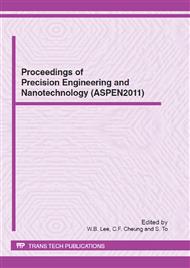p.281
p.287
p.293
p.299
p.305
p.311
p.317
p.321
p.326
Design and Manufacture of Light Collimator with Narrow View Angle
Abstract:
The use of LED for illumination offers significant advantages, such as lower power consumption, longer lifetime and improved colour management. Sharp gradients in luminous intensity patterns of LED are commonly controlled by the use of secondary optics that are mostly axisymmetric. In the current study, we proposed LED secondary optics forming non-axisymmetric luminous intensity distribution with an extremely narrow view angle. The proposed secondary optics dramatically reduced the view angle of the LED, with a view angle ( 10º) in full width at half maximum (FWHM) in simulations. Afterward, a prototype of the proposed lens was machined by single point diamond turning (SPDT). Luminous intensity distribution of the machined lens was off by about 8º from the optical axis and maintained a view angle of 12º. The peak luminous intensity was folded more than thirty-two times. The proposed lens showed high optical performance and can be used for specialized optical applications.
Info:
Periodical:
Pages:
305-310
Citation:
Online since:
June 2012
Authors:
Keywords:
Price:
Сopyright:
© 2012 Trans Tech Publications Ltd. All Rights Reserved
Share:
Citation:


